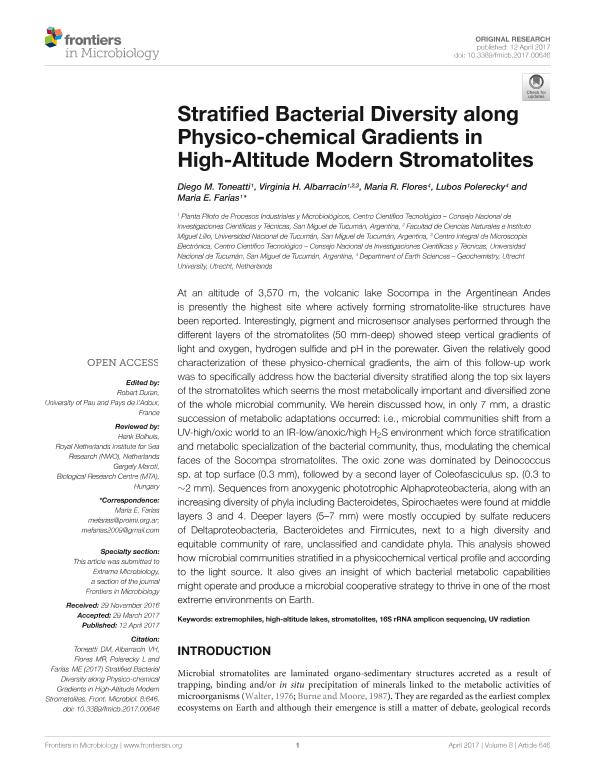Artículo
Stratified bacterial diversity along physico-chemical gradients in high-altitude modern stromatolites
Toneatti, Diego ; Albarracín, Virginia Helena
; Albarracín, Virginia Helena ; Flores, Maria R.; Polerecky, Lubos; Farias, Maria Eugenia
; Flores, Maria R.; Polerecky, Lubos; Farias, Maria Eugenia
 ; Albarracín, Virginia Helena
; Albarracín, Virginia Helena ; Flores, Maria R.; Polerecky, Lubos; Farias, Maria Eugenia
; Flores, Maria R.; Polerecky, Lubos; Farias, Maria Eugenia
Fecha de publicación:
04/2017
Editorial:
Frontiers
Revista:
Frontiers in Microbiology
e-ISSN:
1664-302X
Idioma:
Inglés
Tipo de recurso:
Artículo publicado
Clasificación temática:
Resumen
At an altitude of 3,570 m, the volcanic lake Socompa in the Argentinean Andes is presently the highest site where actively forming stromatolite-like structures have been reported. Interestingly, pigment and microsensor analyses performed through the different layers of the stromatolites (50 mm-deep) showed steep vertical gradients of light and oxygen, hydrogen sulfide and pH in the porewater. Given the relatively good characterization of these physico-chemical gradients, the aim of this follow-up work was to specifically address how the bacterial diversity stratified along the top six layers of the stromatolites which seems the most metabolically important and diversified zone of the whole microbial community. We herein discussed how, in only 7 mm, a drastic succession of metabolic adaptations occurred: i.e., microbial communities shift from a UV-high/oxic world to an IR-low/anoxic/high H2S environment which force stratification and metabolic specialization of the bacterial community, thus, modulating the chemical faces of the Socompa stromatolites. The oxic zone was dominated by Deinococcus sp. at top surface (0.3 mm), followed by a second layer of Coleofasciculus sp. (0.3 to ~2 mm). Sequences from anoxygenic phototrophic Alphaproteobacteria, along with an increasing diversity of phyla including Bacteroidetes, Spirochaetes were found at middle layers 3 and 4. Deeper layers (5-7 mm) were mostly occupied by sulfate reducers of Deltaproteobacteria, Bacteroidetes and Firmicutes, next to a high diversity and equitable community of rare, unclassified and candidate phyla. This analysis showed how microbial communities stratified in a physicochemical vertical profile and according to the light source. It also gives an insight of which bacterial metabolic capabilities might operate and produce a microbial cooperative strategy to thrive in one of the most extreme environments on Earth.
Archivos asociados
Licencia
Identificadores
Colecciones
Articulos(PROIMI)
Articulos de PLANTA PILOTO DE PROC.IND.MICROBIOLOGICOS (I)
Articulos de PLANTA PILOTO DE PROC.IND.MICROBIOLOGICOS (I)
Citación
Toneatti, Diego; Albarracín, Virginia Helena; Flores, Maria R.; Polerecky, Lubos; Farias, Maria Eugenia; Stratified bacterial diversity along physico-chemical gradients in high-altitude modern stromatolites; Frontiers; Frontiers in Microbiology; 8; 4-2017; 1-12
Compartir
Altmétricas



